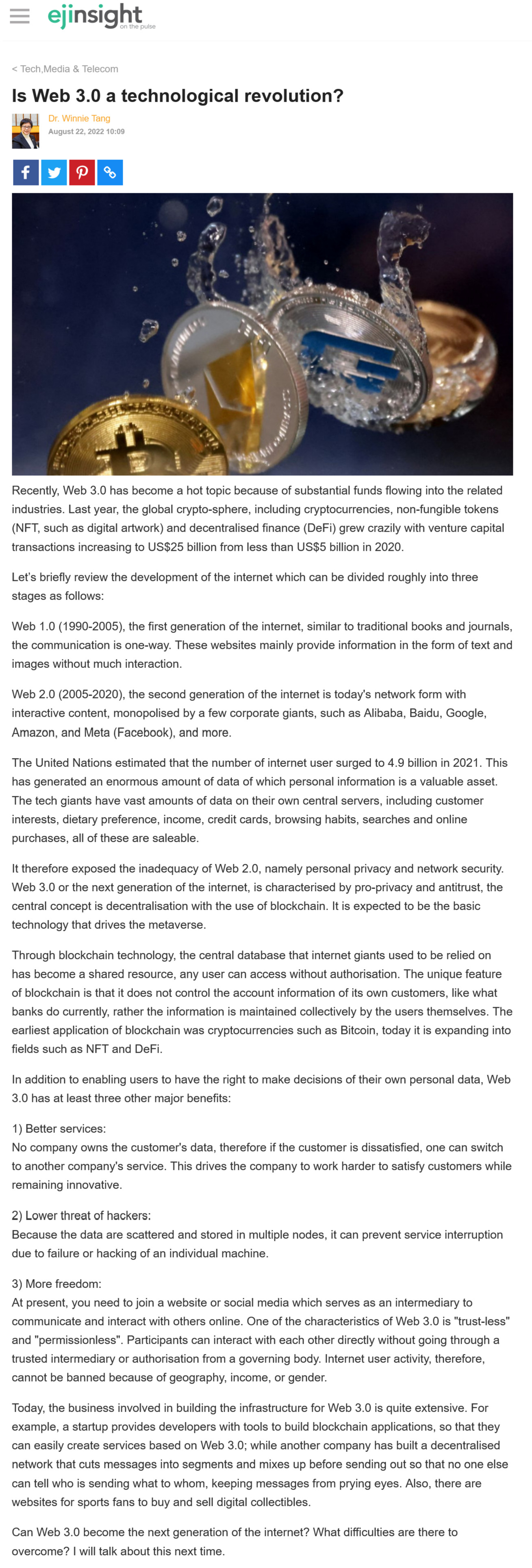網上版請按此

Is Web 3.0 a technological revolution?
Recently, Web 3.0 has become a hot topic because of substantial funds flowing into the related industries. Last year, the global crypto-sphere, including cryptocurrencies, non-fungible tokens (NFT, such as digital artwork) and decentralised finance (DeFi) grew crazily with venture capital transactions increasing to US$25 billion from less than US$5 billion in 2020.
Let's briefly review the development of the internet which can be divided roughly into three stages as follows:
Web 1.0 (1990-2005), the first generation of the internet, similar to traditional books and journals, the communication is one-way. These websites mainly provide information in the form of text and images without much interaction.
Web 2.0 (2005-2020), the second generation of the internet is today's network form with interactive content, monopolised by a few corporate giants, such as Alibaba, Baidu, Google, Amazon, and Meta (Facebook), and more.
The United Nations estimated that the number of internet user surged to 4.9 billion in 2021. This has generated an enormous amount of data of which personal information is a valuable asset. The tech giants have vast amounts of data on their own central servers, including customer interests, dietary preference, income, credit cards, browsing habits, searches and online purchases, all of these are saleable.
It therefore exposed the inadequacy of Web 2.0, namely personal privacy and network security.
Web 3.0 or the next generation of the internet, is characterised by pro-privacy and antitrust, the central concept is decentralisation with the use of blockchain. It is expected to be the basic technology that drives the metaverse.
Through blockchain technology, the central database that internet giants used to be relied on has become a shared resource, any user can access without authorisation. The unique feature of blockchain is that it does not control the account information of its own customers, like what banks do currently, rather the information is maintained collectively by the users themselves. The earliest application of blockchain was cryptocurrencies such as Bitcoin, today it is expanding into fields such as NFT and DeFi.
In addition to enabling users to have the right to make decisions of their own personal data, Web 3.0 has at least three other major benefits:
1) Better services:
No company owns the customer's data, therefore if the customer is dissatisfied, one can switch to another company's service. This drives the company to work harder to satisfy customers while remaining innovative.
2) Lower threat of hackers:
Because the data are scattered and stored in multiple nodes, it can prevent service interruption due to failure or hacking of an individual machine.
3) More freedom:
At present, you need to join a website or social media which serves as an intermediary to communicate and interact with others online. One of the characteristics of Web 3.0 is "trust-less" and "permissionless". Participants can interact with each other directly without going through a trusted intermediary or authorisation from a governing body. Internet user activity, therefore, cannot be banned because of geography, income, or gender.
Today, the business involved in building the infrastructure for Web 3.0 is quite extensive. For example, a startup provides developers with tools to build blockchain applications, so that they can easily create services based on Web 3.0; while another company has built a decentralised network that cuts messages into segments and mixes up before sending out so that no one else can tell who is sending what to whom, keeping messages from prying eyes. Also, there are websites for sports fans to buy and sell digital collectibles.
Can Web 3.0 become the next generation of the internet? What difficulties are there to overcome? I will talk about this next time.
Dr. Winnie Tang
Adjunct Professor, Department of Computer Science, Faculty of Engineering; Department of Geography, Faculty of Social Sciences; and Faculty of Architecture, The University of Hong Kong